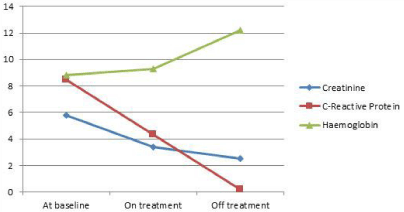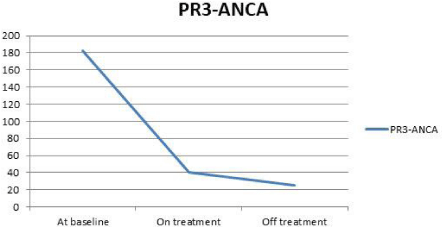
Case Report
Thromb Haemost Res. 2020; 4(1): 1039.
Efficacy of Plasma-Exchange in a Rare Wegener Granulomatosis Pediatric Case
Quartarone EU, Petrungaro AN* and Alonci AN
Department of Services, University of Messina, Italy
*Corresponding author: Annamaria Petrungaro, Department of Services, University of Messina, via Consolare Valeria 1, 98124 Messina, Italy
Received: January 08, 2019; Accepted: January 24, 2020; Published: January 31, 2020
Abstract
Granulomatosis with Polyangiitis (GPA), previously known as Wegener Granulomatosis, is a rare multisystem autoimmune disease. GPA is usually linked with the presence of diffuse staining (c-ANCA) directed against serine Proteinase 3 Antigen (PR3-ANCA), the so-called Wegener autoantigen. The standard induction therapy matches to use rituximab or cyclophosphamide, each in combination with Glucocorticoids (GC). In the absence of severe organ involvement, methotrexate can alternatively be used. Plasma-Exchange (PE) may be considered in patients with rapidly progressive renal disease (serum creatinine level ›5.65mg/dL, active urine sediment and eGFR ‹50 ml/ min/1.73m2 calculated with Cockroft-Gault formula) in order to preserve renal function or pulmonary hemorrhage. Herein we report a pediatric case of severe GPA with mild renal involvement, which showed significant clinical improvement after PE. In this report PE has been able to improve the rapid worsening of renal function.We found out PE effect on serum ANCA levels and its correlation with renal function in patients with GPA and ANCA-associated vasculitis.
Keywords: Plasma-exchange; Anti-neutrophil cytoplasmic antibodies; Granulomatosis with polyangiitis
Introduction
Granulomatosis with Polyangiitis (GPA), previously known as Wegener Granulomatosis, is a rare multisystem autoimmune disease described by necrotizing granulomatosis inflammation and pauciimmune vasculitis in small- and medium-sized blood vessels that come about particularly in the upper and lower respiratory tracts and kidneys [1]. The pathophysiology of GPA is associated with the Anti-Neutrophil Cytoplasmic Antibodies (c-ANCA) existence within neutrophils in the majority of patients that is included in the group of ANCA-associated small vessel vasculitides and this hinted the role of humoral autoimmunity [2]. GPA is usually linked with the presence of diffuse staining (c-ANCA) directed against serine proteinase 3 antigen (PR3-ANCA), the so-called Wegener autoantigen. Fewer than 20% of patients with GPA have a perinuclear pattern identifying with the autoantigen Myeloperoxidase (MPO) [3].
The standard induction therapy matches to use rituximab or cyclophosphamide, each in combination with Glucocorticoids (GC). In the absence of severe organ involvement, methotrexate can alternatively be used. After remission, maintenance treatment with azathioprine, methotrexate or rituximab should be given for at least 48 months [4].
Plasma-Exchange (PE) may be considered in patients with rapidly progressive renal disease (serum creatinine level ›5.65mg/ dL, active urine sediment and eGFR ‹50 ml/min/1.73m2 calculated with Cockroft-Gault formula) in order to preserve renal function or pulmonary hemorrhage (diffuse pulmonary infiltrates on the chest x-ray or CT scan that could not be explained otherwise than by alveolar hemorrhage due to active vasculitis) [5,6]. Since PE is a therapeutic method based on removal of high molecular weight particles from blood. Herein we report a pediatric case of severe GPA with mild renal involvement, which showed significant clinical improvement after plasma-exchange.
Case Report
An 11 year old Caucasian girl came to our observation as affected by Wegener Granulomatosis with a spectrum of clinical symptoms that included: fatigue, lethargy, appetite loss, weight loss, rhinitis, epistaxis, chest pain, renal failure and anemia. First line therapy using corticosteroids, cyclophosphamide and methotrexate was performed without any benefit. In September 2017 a course of thirteen plasmaexchange sessions was started, twice a week for two months through central venous access in the femoral vein. The Fresenius COM.TEC cell separator was used. Patient’s height was 134 cm and she weighed 36kg. Before plasma-exchange therapy we observed a Haemoglobin (Hb) value of 8.8 gr/dL and a creatinine value of 5.8mg/dl, C-Reactive Protein (CRP) was 8.5 mg/l and serum c-ANCA levels measured 182.4 IU/ml.The priming of the procedure was performed with a previously packed filtered and washed red blood cell unit. Treated blood’s entire volume was on average 2300 ml and we exchanged on average 1400 ml of substitution liquid consisting of Fresh Frozen Plasma (FFP) derived from industrial processing. ACD-A was used as an anticoagulant, while ACD-A related hypocalcemic syndrome was treated according to guidelines.At the end of the plasma-exchange cycle all clinical features were significantly improved, notably Hb value: 12.2gr/dl and creatinine value: 2.5mg/dl (Figure 1). Moreover a decrease of PR3-ANCA (Figure 2) and CRP was found: 25IU/ml and 0.2mg/dl, respectively. After 12 months we observed a renal relapse. To date this patient requires dialysis and kidney transplant.

Figure 1: Evolution of changes in creatinine levels, CPR values, and LDH
levels following plasma-exchange treatment.

Figure 2: PR3-ANCA trend during plasma-exchange treatment.
Discussion
The mainstay of treatment for GPA is a combination of corticosteroids and cytotoxic agents. Van der Woude et al. reported that cytoplasmic (c)-ANCA is highly specific for active GPA and that c-ANCA titres are directly related to GPA disease activity [3]. Plasma-exchange has been studied as a potential therapeutic choise in ANCA-Associated Vasculitides (AAV) but there is still insufficient evidence to recommend it as the first line treatment [7]. Jayne DRW et al. showed that plasma-exchange may be used as adjuvant therapy for patients with progressive disease despite induction therapy with high-dose glucocorticoids and cyclophosphamide or rituximab [8]. Otherwise the PEXIVAS clinical trial proved that plasma- exchange did not improve clinical outcomes at the end in antineutrophil cytoplasmic antibody (c-ANCA)-associated vasculitis [9]. To date, the correct use of plasma-exchange in AAV is controversial.
In this report PE has been able to improve the rapid worsening of renal function.We found out plasma-exchange effect on serum ANCA levels and its correlation with renal function in patients with GPA and ANCA-associated vasculitis.
Efficacy of plasma-exchange in ANCA removal and its impact on disease activity has not been adequately investigated so far, no clinical trial has been conducted in the pediatric population and no pediatric specific recommendations are available.
Declarations
Ethics approval and consent to participate: This manuscript does not report on or involve the use of any animal or human data or tissue.
Availability of data and materials
All data generated or analysed during this study are included in this published article and its supplementary information files.
References
- Greco A, Marinelli C, Fusconi M, Macri GF. Clinic manifestations in granulomatosis with polyangiitis. Int J Immunopathol Pharmacol. 2016; 29: 151–159.
- Lutalo PM, D’ Cruz DP. Diagnosis and classification of granulomatosis with polyangiitis (aka Wegener’s granulomatosis). J Autoimmun. 2014; 48-49: 94- 98.
- Van der Woude FJ, Rasmussen N, Lobatto S, Wiik A, Wiik A, Permin H, van Es LA, et al. Autoantibodies against neutrophils and monocytes: tool for diagnosis and marker of disease activity in Wegener’s granulomatosis. Lancet. 1985; 1: 425-429.
- Hellmich B. ANCA-associated vasculitides: State of the art. Z Rheumatol. 2019; 78: 518-528.
- Yates M, Watts RA, Bajema IM, Cid MC, Crestani B, Hauser T, et al. EULAR/ ERA-EDTA recommendations for the management of ANCA-associated vasculitis. Ann Rheum Dis. 2016; 75: 1583–1594.
- Schirmer JH, Aries PM, De Groot K, Bernhard Hellmich, Julia U. Holle, Christian Kneitz, et al. S1 Leitlinie zur Diagnose und Therapie der ANCA assoziierten Vaskulitiden. Z Rheumato. 2017; l76: 77–104.
- Szpirt WM. Plasma exchange in antineutrophil cytoplasmic antibodyassociated vasculitis - a 25-year perspective. Nephrol Dial Transplant. 2015; 30: 146-149.
- Jayne DRW, Gaskin G, Rasmussen N, Abramowicz, Ferrario F, Guillevin L, et al. Randomized trial of plasma ex-change or high-dosage methylprednisolone as adjunctive therapy for severe renal vasculitis. J Am Soc Nephrol. 2007; 18: 2180–2188.
- Walsh M, Merkel PA, Peh CA, Szpirt W, Guillevin L, Pusey CD, et al. Plasma exchange and glucocorticoid dosingin the treatment of anti-neutrophil cytoplasm antibody associated vasculitis (PEXIVAS): protocol for a randomized controlled trial. Trials. 2013; 3: 14-73.